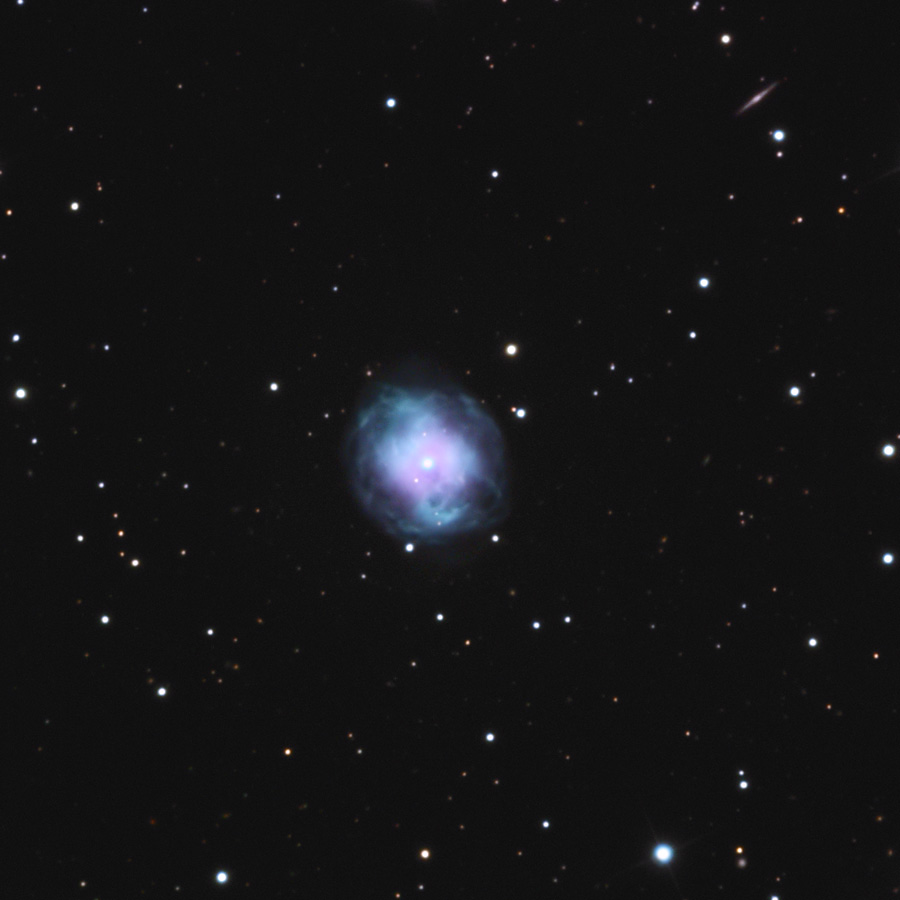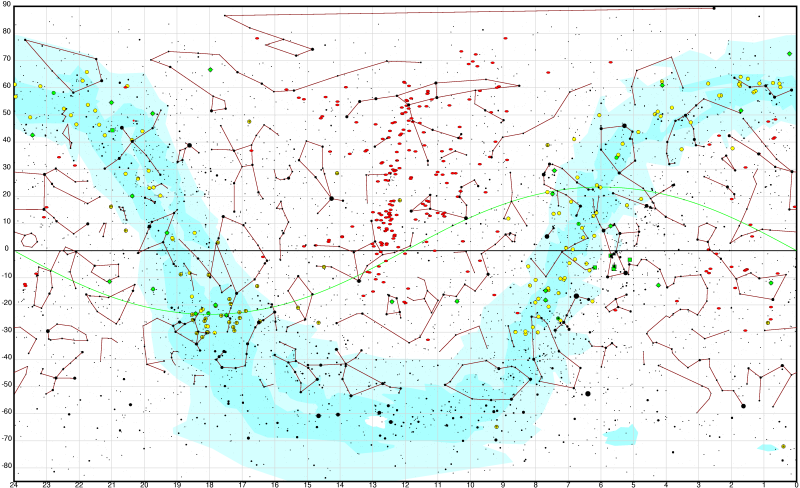|
NGC 4361
NGC 4361 (also known as the Lawn Sprinkler Nebula or Garden Sprinkler Nebula) is a planetary nebula in the constellation of Corvus. It is included in the Astronomical League's Herschel 400 Observing Program. Central star NGC 4361's central star is an extremely hot CWolf-Rayet type star. Its temperature is 126,000 K. It is nearly 18,000 times brighter than the Sun, but is only 6.1% its size. This star left the asymptotic giant branch between 5776 and 8018 years ago. Gallery File:NGC 4361 legacy dr10.jpg, NGC 4361 with legacy surveys File:NGC 4361.jpg, NGC 4361 imaged in infrared by the Spitzer Space Telescope The Spitzer Space Telescope, formerly the Space Infrared Telescope Facility (SIRTF), was an infrared space telescope launched in 2003. Operations ended on 30 January 2020. Spitzer was the third space telescope dedicated to infrared astronomy, f ... References External links * Corvus (constellation) Planetary nebulae 4361 {{nebula-stub Wolf–Rayet ... [...More Info...] [...Related Items...] OR: [Wikipedia] [Google] [Baidu] |
New General Catalogue
The ''New General Catalogue of Nebulae and Clusters of Stars'' (abbreviated NGC) is an astronomical catalogue of deep-sky objects compiled by John Louis Emil Dreyer in 1888. The NGC contains 7,840 objects, including galaxies, star clusters and emission nebulae. Dreyer published two supplements to the NGC in 1895 and 1908, known as the ''Index Catalogues'' (abbreviated IC), describing a further 5,386 astronomical objects. Thousands of these objects are best known by their NGC or IC numbers, which remain in widespread use. The NGC expanded and consolidated the cataloguing work of William and Caroline Herschel, and John Herschel's ''General Catalogue of Nebulae and Clusters of Stars''. Objects south of the celestial equator are catalogued somewhat less thoroughly, but many were included based on observation by John Herschel or James Dunlop. The NGC contained multiple errors, but attempts to eliminate them were made by the ''Revised New General Catalogue'' (RNGC) by Jack W. Sulent ... [...More Info...] [...Related Items...] OR: [Wikipedia] [Google] [Baidu] |
J2000
In astronomy, an epoch or reference epoch is a instant, moment in time used as a reference point for some time-varying astronomical quantity. It is useful for the celestial coordinates or orbital elements of a Astronomical object, celestial body, as they are subject to Perturbation (astronomy), perturbations and vary with time. These time-varying astronomical quantities might include, for example, the mean longitude or mean anomaly of a body, the node of its orbit relative to a reference plane, the direction of the apogee or Perihelion and aphelion, aphelion of its orbit, or the size of the major axis of its orbit. The main use of astronomical quantities specified in this way is to calculate other relevant parameters of motion, in order to predict future positions and velocities. The applied tools of the disciplines of celestial mechanics or its subfield orbital mechanics (for predicting orbital paths and positions for bodies in motion under the gravitational effects of other bodi ... [...More Info...] [...Related Items...] OR: [Wikipedia] [Google] [Baidu] |
Corvus (constellation)
Corvus is a small constellation in the Southern Celestial Hemisphere. Its name means "crow" in Latin. One of the 48 constellations listed by the 2nd-century astronomer Ptolemy, it depicts a raven, a bird associated with stories about the god Apollo, perched on the back of Hydra (constellation), Hydra the water snake. The four brightest stars, Gamma Corvi, Gamma, Delta Corvi, Delta, Epsilon Corvi, Epsilon, and Beta Corvi, form a distinctive quadrilateral in the night sky. With an apparent magnitude of 2.59, Gamma Corvi—also known as Gienah—is the brightest star in the constellation. It is an aging blue giant around four times as solar mass, massive as the Sun. The young star Eta Corvi has been found to have two debris disks. Three star systems have exoplanets, and a fourth planetary system is unconfirmed. TV Corvi is a dwarf nova—a white dwarf and brown dwarf in very binary star, close orbit. History and mythology In the Babylonian star catalogues dating from at least 110 ... [...More Info...] [...Related Items...] OR: [Wikipedia] [Google] [Baidu] |
Planetary Nebula
A planetary nebula (PN, plural PNe) is a type of emission nebula consisting of an expanding, glowing shell of ionized gas ejected from red giant stars late in their lives. The term "planetary nebula" is a misnomer because they are unrelated to planets. The term originates from the planet-like round shape of these nebulae observed by astronomers through early telescopes. The first usage may have occurred during the 1780s with the English astronomer William Herschel who described these nebulae as resembling planets; however, as early as January 1779, the French astronomer Antoine Darquier de Pellepoix described in his observations of the Ring Nebula, "very dim but perfectly outlined; it is as large as Jupiter and resembles a fading planet". Though the modern interpretation is different, the old term is still used. All planetary nebulae form at the end of the life of a star of intermediate mass, about 1-8 solar masses. It is expected that the Sun will form a planetary nebula a ... [...More Info...] [...Related Items...] OR: [Wikipedia] [Google] [Baidu] |
Astronomical League
The Astronomical League is an umbrella organization of amateur astronomy societies. Currently their membership consists of over 280 organizations across the United States, along with a number of Members-at-Large, Patrons, and Supporting members. The mission of the Astronomical League is to promote the science of astronomy by (1) fostering astronomical education; (2) providing incentives for astronomical observation and research; and (3) assisting communication among amateur astronomical societies. The Astronomical League provides a number of observing awards to members locating and describing certain specified astronomical objects or events, and produces a periodical publication, ''The Reflector''. History The beginning of the Astronomical League dates back to 1939 when members of eleven amateur astronomical societies met at the American Museum of Natural History in New York City. Similar meetings followed in Pittsburgh, 1940, Washington D.C., 1941, and Detroit, 1946. At the la ... [...More Info...] [...Related Items...] OR: [Wikipedia] [Google] [Baidu] |
Herschel 400 Catalogue
The Herschel 400 catalogue is a subset of William Herschel, William Herschel's original ''Catalogue of Nebulae and Clusters of Stars'', selected by Brenda F. Guzman (Branchett), Lydel Guzman, Paul Jones, James Morrison, Peggy Taylor and Sara Saey of the Ancient City Astronomy Club in St. Augustine, Florida, United States c. 1980. They decided to generate the list after reading a letter published in Sky and telescope, ''Sky & Telescope'' by James Mullaney of Pittsburgh, Pennsylvania, Pittsburgh, Pennsylvania, USA. In this letter Mr. Mullaney suggested that William Herschel's original catalogue of 2,500 objects would be an excellent basis for deep sky object selection for amateur astronomers looking for a challenge after completing the Messier Catalogue. The Herschel 400 is a subset of John Herschel's ''General Catalogue of Nebulae and Clusters'' published in 1864 of 5,000 objects, and hence also of the ''New General Catalogue''. The catalogue forms the basis of thAstronomical Leagu ... [...More Info...] [...Related Items...] OR: [Wikipedia] [Google] [Baidu] |
Asymptotic Giant Branch
The asymptotic giant branch (AGB) is a region of the Hertzsprung–Russell diagram populated by evolved cool luminous stars. This is a period of stellar evolution undertaken by all low- to intermediate-mass stars (about 0.5 to 8 solar masses) late in their lives. Observationally, an asymptotic-giant-branch star will appear as a bright red giant with a luminosity ranging up to thousands of times greater than the Sun. Its interior structure is characterized by a central and largely inert core of carbon and oxygen, a shell where helium is undergoing fusion to form carbon (known as helium burning), another shell where hydrogen is undergoing fusion forming helium (known as hydrogen burning), and a very large envelope of material of composition similar to main-sequence stars (except in the case of carbon stars). Stellar evolution When a star exhausts the supply of hydrogen by nuclear fusion processes in its core, the core contracts and its temperature increases, causing the outer l ... [...More Info...] [...Related Items...] OR: [Wikipedia] [Google] [Baidu] |
Dark Energy Spectroscopic Instrument
The Dark Energy Spectroscopic Instrument (DESI) is a scientific research instrument for conducting spectrographic astronomical surveys of distant galaxies. Its main components are a focal plane containing 5,000 fiber-positioning robots, and a bank of spectrographs which are fed by the fibers. The new instrument will enable an experiment to probe the expansion history of the universe and the mysterious physics of dark energy. The instrument is operated by the Lawrence Berkeley National Laboratory under funding from the US Department of Energy's Office of Science. Construction of the new instrument, now completed, was principally funded by the US Department of Energy's Office of Science, and by other numerous sources including the US National Science Foundation, the UK Science and Technology Facilities Council, France's Alternative Energies and Atomic Energy Commission, Mexico's National Council of Science and Technology, Spain's Ministry of Science and Innovation, by the Gordon ... [...More Info...] [...Related Items...] OR: [Wikipedia] [Google] [Baidu] |
Infrared
Infrared (IR), sometimes called infrared light, is electromagnetic radiation (EMR) with wavelengths longer than those of visible light. It is therefore invisible to the human eye. IR is generally understood to encompass wavelengths from around 1 millimeter (300 GHz) to the nominal red edge of the visible spectrum, around 700 nanometers (430 THz). Longer IR wavelengths (30 μm-100 μm) are sometimes included as part of the terahertz radiation range. Almost all black-body radiation from objects near room temperature is at infrared wavelengths. As a form of electromagnetic radiation, IR propagates energy and momentum, exerts radiation pressure, and has properties corresponding to both those of a wave and of a particle, the photon. It was long known that fires emit invisible heat; in 1681 the pioneering experimenter Edme Mariotte showed that glass, though transparent to sunlight, obstructed radiant heat. In 1800 the astronomer Sir William Herschel discovered ... [...More Info...] [...Related Items...] OR: [Wikipedia] [Google] [Baidu] |
Spitzer Space Telescope
The Spitzer Space Telescope, formerly the Space Infrared Telescope Facility (SIRTF), was an infrared space telescope launched in 2003. Operations ended on 30 January 2020. Spitzer was the third space telescope dedicated to infrared astronomy, following IRAS (1983) and ISO (1995–1998). It was the first spacecraft to use an Earth-trailing orbit, later used by the Kepler planet-finder. The planned mission period was to be 2.5 years with a pre-launch expectation that the mission could extend to five or slightly more years until the onboard liquid helium supply was exhausted. This occurred on 15 May 2009. Without liquid helium to cool the telescope to the very low temperatures needed to operate, most of the instruments were no longer usable. However, the two shortest-wavelength modules of the IRAC camera continued to operate with the same sensitivity as before the helium was exhausted, and continued to be used into early 2020 in the Spitzer Warm Mission. During the warm mission, t ... [...More Info...] [...Related Items...] OR: [Wikipedia] [Google] [Baidu] |
Planetary Nebulae
A planetary nebula (PN, plural PNe) is a type of emission nebula consisting of an expanding, glowing shell of ionized gas ejected from red giant stars late in their lives. The term "planetary nebula" is a misnomer because they are unrelated to planets. The term originates from the planet-like round shape of these nebulae observed by astronomers through early telescopes. The first usage may have occurred during the 1780s with the English astronomer William Herschel who described these nebulae as resembling planets; however, as early as January 1779, the French astronomer Antoine Darquier de Pellepoix described in his observations of the Ring Nebula, "very dim but perfectly outlined; it is as large as Jupiter and resembles a fading planet". Though the modern interpretation is different, the old term is still used. All planetary nebulae form at the end of the life of a star of intermediate mass, about 1-8 solar masses. It is expected that the Sun will form a planetary neb ... [...More Info...] [...Related Items...] OR: [Wikipedia] [Google] [Baidu] |








